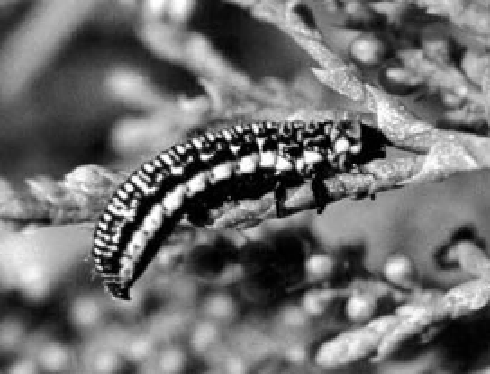Geoscience Reference
In-Depth Information
Saltcedar forms dense thickets along waterways,
including the upper Arkansas River valley. These
thickets crowd out native vegetation, degrade
wildlife habitat, harm some 50 endangered or
threatened native species, cause increases in
wildi res and soil salinity, inhibit grazing and
agricultural land use, and impede recreational
use of parks and natural areas.
As a facultative phreatophyte and halophyte,
saltcedar has signii cant advantages over native,
obligate phreatophytes (Zouhar 2003). Follow-
ing i re or cutting of the above-ground plant,
new growth takes place readily from the root
crown. It grows in soil with up to 50‰ salinity.
Excess salt is collected in special glands in the
leaves and then excreted onto the leaf surface.
When these leaves fall to the ground, they con-
tribute to soil salinity. For controlled rivers,
lacking regular l ooding and scouring, increased
soil salinity inhibits seed germination and
growth of native plants. In the Arkansas River
valley, for instance, damming and water extrac-
tions dramatically reduce the intensity and
recurrence interval of downstream l ooding and
may give
Tamarix
a competitive advantage over
such native species as cottonwood (
Populus del-
toides
) and willow (
Salix exigua
) (Lovell, Gibson
and Heschel 2009).
Once established, saltcedar is extremely tena-
cious and difi cult to eradicate through mechan-
ical (cutting) or chemical (herbicide) means, or
with i re (Zouhar 2003). Integrated (multiple)
methods are more successful
-
for example,
application of selected herbicides to freshly cut
stumps prior to the growing season (e.g. Fick
and Geyer 2010), which is labor-intensive and
expensive. Another approach involves periodic
dam releases to create pulse l oods and over-
bank l ooding, which simulate natural river
behavior and favor native species (Zouhar 2003).
Because of the numerous problems created by
the
Tamarix
invasion, the Saltcedar Biological
Control Consortium (SBCC) was established
with numerous federal and state agencies,
private organizations, and international partners
(DeLoach and Gould 1998; SBCC 2011).
A leaf-eating beetle,
Diorhabda “elongata”
(saltcedar leaf beetle), now named
D. carinu-
lata
, is a natural enemy of saltcedar (Fig. 16-11).
Figure 16-11.
Diorhabda carinulata,
imported from
northwestern China, on saltcedar. Third instar larva
(
∼
8 mm long). Photo courtesy of D. Eberts.
In their larval and adult stages,
D. carinulata
eat the leaves and outer layers of stem tissue
of saltcedar (and no other plants), and may
defoliate the plant to such an extent that it
eventually dies. These beetles were imported
from Fukang, northwestern China and Chilik,
eastern Kazakhstan (Dudley et al. 2010).
The carefully managed international biocontrol
program proceeded in several steps (DeLoach
et al. 2007):
• Ten years testing
D. carinulata
imported
from central Asia under quarantine condi-
tions in Texas and California, starting in
1986.
• Release of
D. carinulata
into secure i eld
cages at authorized research sites in 1997.
• Field release into the open within circum-
scribed areas at ten approved sites in six
western states in 2001. One of these sites
was located on the Arkansas River l ood-
plain near Pueblo, Colorado (Fig. 16-12).
• Additional i eld releases of
Diorhabda
sp.
imported from Crete, Greece in two south-
western states in 2003.
• Release of Greek
Diorhabda
sp. at study
sites in northeastern Mexico along the Rio
Grande in 2007.
Field releases of saltcedar leaf beetles had
rapid and dramatic impacts on saltcedar with





